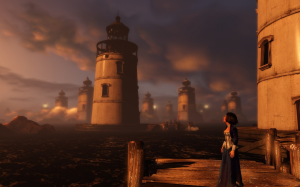Bioshock Infinite is Infinitely Intriguing
March 13, 2014
Bioshock Infinite is a great game that came out almost a year ago, on March 26, 2013, that I’ve been hesitant to review due to the fact that details about the games characters and plot would be so integral to the review.
The details and plot points are the subject of major spoilers within the game but as almost a year has passed since its release, I’d say the statute of limitations has run out. Keep in mind that this will review will spoil the ending and major plot points of the game, so proceed at your own risk.
Bioshock Infinite knows how to tell a story right from the beginning as it pays tribute to the first Bioshock by plunking the player down in the middle of an ocean, headed toward a lighthouse. Unlike the lighthouse from the first game, this lighthouse doesn’t lead to the capitalist paradise that is the underwater city of Rapture.
Instead this lighthouse rockets the player into the floating city of Columbia, in 1912, where the founding fathers of America are hailed as gods and racism is alive and well. The player character, Booker DeWitt, is sent there by the mysterious twins Robert and Rosalind Lutece, on a mission bring them the girl and wipe away his debt. What debt is to be wiped away is not made obvious to the player immediately, but is revealed as the game progresses.
Once in Columbia, Booker finds Elizabeth, the girl he was sent to retrieve and daughter of the founder of Columbia, Zachary Comstock. Elizabeth has the power to open “tears” in the fabric of space-time that Comstock has been using to make prophecies and plagiarize technology from the future.
A nice touch in this respect is that music from future makes an appearance in Columbia. Cyndi Lauper’s “Girls Just Want To Have Fun” can be heard on a calliope and The Beach Boys’ “God Only Knows” makes an appearance being sung by a barbershop quartet during your first moments in Columbia. This dedication to atmosphere is beautiful and has been a staple of the Bioshock series since its inception in 2007.
The story is Bioshock Infinite’s strong suit, while gameplay takes a back seat. Bioshock Infinite’s story stays compelling by playing with the idea of the universes within each of the tears. Depending on the tear, a person may not have existed or a cache of weapons may appear where it previously was not.
The story even ties back into the original Bioshock in many points. The theme of the game is best summed up in a quote neat the end of the game, “constants and variables.” The most interesting of these variables are the characters themselves and result in a twist ending no one saw coming in which six characters are actually only three. Booker and Comstock are the same man whose decisions led to different outcomes, Booker’s child, Anna, whom he sold to pay his debts and Elizabeth are the same girl, and Rosalind and Robert Lutece are the same person from different universes where the only differences between them are a single chromosome.
If this sounds like a mess, it’s really not. It’s a little difficult to wrap your head around at first but makes perfect sense in the game and will seem totally obvious on subsequent playthroughs. Still, I can’t spoil everything, so if you’d like to see how all those plot lines tie together, you’ll have to play the game.
While the story is mind-blowingly amazing, the same can’t be said for the gameplay, which devolved into mindless shooting rather quickly. It got to the point where, at least to me, fighting a swarm of enemies became a chore that had to be done between moments when the story is expanded.
Still the gameplay isn’t bad, just underdeveloped and the story more than makes up for that. I recommend Bioshock Infinite to fans of the series and newcomers alike. If you’re a big fan of time travel or parallel universe stories, you’ll still be making sense of the ending weeks after you’ve finished it.
If you’d prefer someone explain it to you though, there are numerous explanations online. Whichever method you choose, Bioshock Infinite is truly a masterpiece of storytelling and one of my arguments for the legitimacy of games as an art form.



